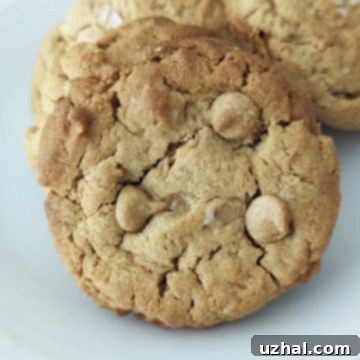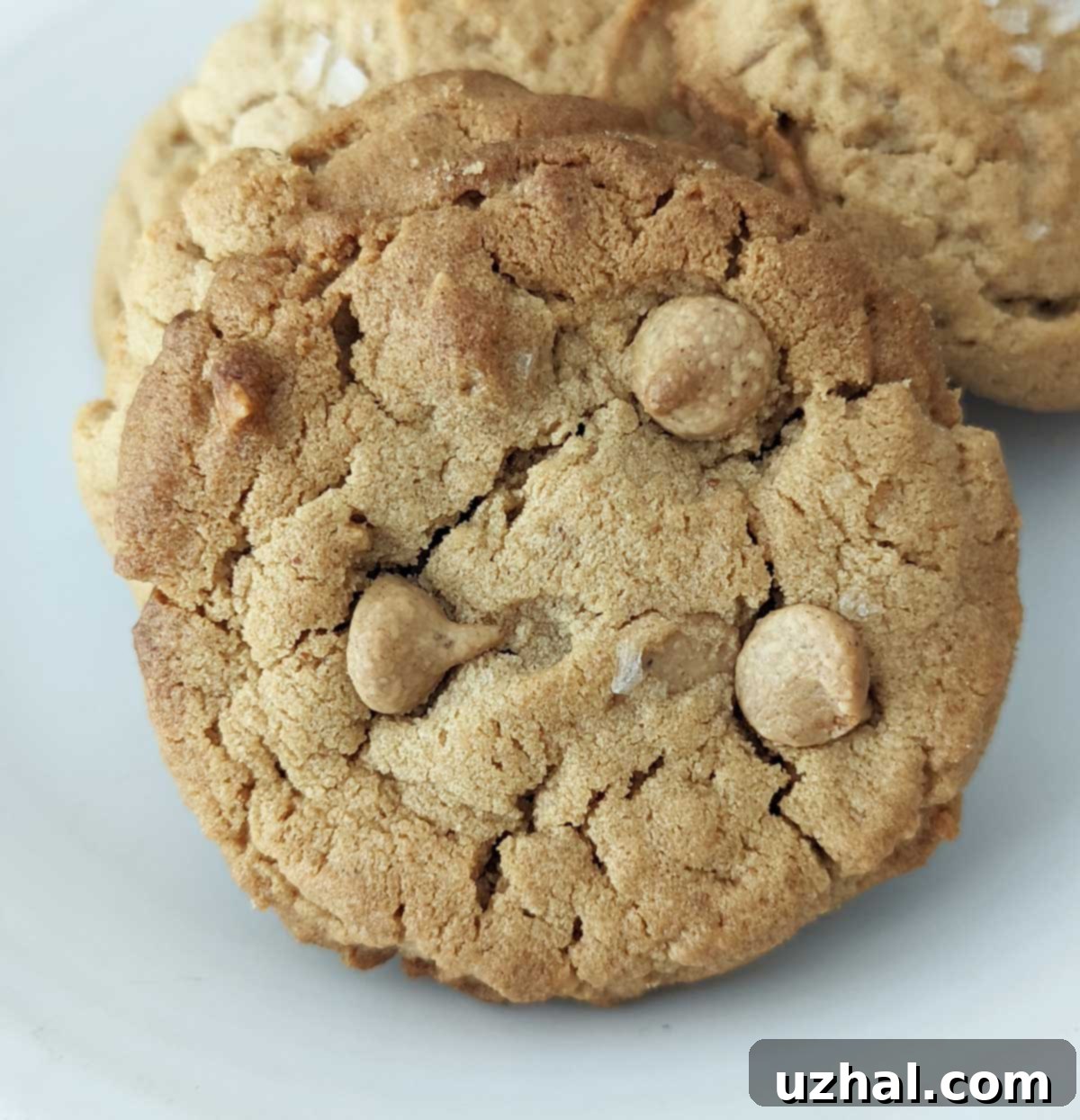Ultimate Quadruple Peanut Butter Cookies: Intense Flavor & Gluten-Free Perfection
For devoted peanut butter enthusiasts, the quest for the ultimate peanut butter cookie is a lifelong journey. While countless recipes promise satisfaction, few deliver that truly profound, unadulterated peanut punch. I’ve sampled a myriad of recipes over the years, from classic family favorites to highly acclaimed versions like King Arthur’s Triple Play Peanut Butter Cookies. Those particular cookies, celebrated for their delicious combination of peanuts, peanut butter, and peanut butter chips, certainly pack a flavorful punch. However, for a true “peanut butter monster” like myself, a craving often lingers for an even more intense, concentrated peanut essence. This insatiable desire led me to explore new avenues for maximizing flavor. And that, my friends, is where powdered peanut butter enters the scene, transforming a beloved classic into something truly extraordinary.
Jump to Recipe
Understanding Powdered Peanut Butter: Your Secret Ingredient
Powdered peanut butter has steadily risen in popularity, becoming a staple in many health-conscious kitchens and a secret weapon for bakers. Essentially, it’s peanuts that have been pressed to remove most of their natural oils, resulting in a fine, dry powder. This process concentrates the rich, roasted peanut flavor while significantly reducing the fat content. While various brands offer different formulations – some incorporating alternative sweeteners like monk fruit or sugar alcohols – the best choice for baking typically contains a simple blend of just peanuts, a touch of sugar, and a hint of salt. This pure composition ensures the authentic peanut taste shines through without unwanted aftertastes or overpowering sweetness from artificial additives. A standard two-tablespoon serving of powdered peanut butter weighs approximately 13 grams, offering a potent flavor boost in a compact form. Should you opt for a variety with an alternative sweetener, rest assured it will perform equally well in this recipe, maintaining the desired texture and enhancing the robust peanut profile.
Introducing: The Quadruple Peanut Butter Cookies
Initially, I considered naming these “Peanut Butter Powder Cookies” to highlight their distinguishing ingredient. However, upon reflection, that name simply doesn’t do justice to the sheer depth of peanut flavor packed into every bite. These cookies feature not one, not two, but *four* distinct forms of peanut goodness! That’s why I’ve affectionately dubbed them “Quadruple Peanut Butter Cookies.” This magnificent quartet ensures a multifaceted peanut experience that truly satisfies even the most fervent peanut butter cravings. What makes them “quadruple”?
- Classic Peanut Butter: Providing the essential creamy base, moisture, and foundational peanut richness.
- Powdered Peanut Butter: Delivering an intense, concentrated roasted peanut flavor without adding excessive fat or moisture, allowing for precise texture control.
- Peanut Butter Chips: Offering delightful pockets of melty, sweet, and tangy peanut butter flavor that burst in your mouth.
- Chopped Peanuts: Adding a crucial textural contrast with their satisfying crunch and a fresh, roasted peanut aroma.
No matter the name, the result is undeniably excellent – a truly exceptional cookie that redefines the peanut butter experience.
Unforgettable Texture and Robust Flavor Profile
Beyond their unparalleled peanut flavor, these cookies boast an incredible texture that sets them apart. They are decidedly not cakey; instead, they offer a delightful crumbly texture with irresistibly soft, yielding centers. This dense, slightly crumbly characteristic is achieved, in part, by carefully controlling the amount of egg in the dough, preventing an overly airy or cake-like crumb. Visually, these cookies are just as appealing, adorned with a charming network of tiny cracks and crevices across their golden-brown tops. This intricate surface pattern is especially pronounced if you bake them in a convection oven, which promotes even heat distribution and beautiful browning. Flavor-wise, they strike a perfect balance: they are not overly sweet, allowing the robust and strong peanut flavor, intensified by the powdered peanut butter, to take center stage. Each bite is a harmonious blend of sweetness, saltiness, and that deep, nutty goodness that peanut butter lovers adore.
Effortless Gluten-Free Peanut Butter Cookies
My initial batches of these delightful cookies were made with traditional flours – specifically, King Arthur bread flour and then King Arthur all-purpose flour. I found a particular fondness for the bread flour version, which lent a lovely chewiness to the cookies. Even a slightly over-baked batch garnered appreciation for its crunchy shell and crumbly interior, reminiscent of nostalgic school lunchroom cookies (though those were a bit too brown!). The good news is, after perfecting the recipe with conventional flours, I put it to the test with Bob’s Red Mill gluten-free 1:1 baking flour, and the results were absolutely perfect! This means you can easily enjoy these wonderfully flavorful and textured peanut butter cookies even if you’re avoiding gluten. They offer a fantastic, more traditional cookie alternative to the incredibly simple Flourless Peanut Butter Cookies, which, while delicious, have a distinctly different texture. When baking gluten-free, remember to weigh your flour for accuracy, as volume measurements can be inconsistent with alternative flours. I encourage all gluten-free bakers to give this recipe a try; I’d truly love to hear about your experience and what you think of them!
Essential Ingredients for Powdered Peanut Butter Cookies
- Butter: Unsalted, and at room temperature. Using unsalted butter allows you to control the overall saltiness of the cookie, ensuring a balanced flavor profile. Room temperature butter creams beautifully with sugars, incorporating air for a light and tender crumb.
- Brown Sugar: Light brown sugar is recommended for its balanced sweetness and moisture, which contributes to the cookies’ chewiness. Dark brown sugar can also be used for a deeper molasses flavor and even chewier texture.
- Granulated Sugar: Provides sweetness and helps create a crisp edge and slight spread, balancing the chewiness from the brown sugar.
- Peanut Butter: The brand and type of peanut butter you choose will indeed influence the final flavor and texture. I’ve achieved excellent results with crunchy Jif, which adds extra texture and a robust, classic peanut butter taste. Natural peanut butter (oil separates) can work, but make sure it’s well-stirred and measure by weight for consistency.
- Powdered Peanut Butter: Crucial for the intense peanut flavor. Opt for a brand that primarily lists peanuts as the ingredient, with a minimal amount of added salt and sugar. I’ve had great success with Wegman’s brand.
- Egg: This recipe uses a slightly reduced amount of lightly beaten egg (2 tablespoons, about 27 grams). This adjustment is key to preventing the cookies from becoming too cakey and instead promotes a denser, more crumbly, and wonderfully chewy texture. Don’t worry about the leftover egg; you can microwave the excess in a small cup for about 30 seconds, let it cool, and offer it as a treat for your dog, or even better, save it to bake a half batch of chocolate chip cookies!
- Baking Powder: A leavening agent that helps the cookies rise slightly and contributes to their tender crumb.
- Baking Soda: Another leavening agent that reacts with the acidic brown sugar, aiding in spread and creating a chewy texture.
- Salt: Essential for balancing the sweetness and enhancing all the flavors, particularly the rich peanut notes.
- Flour: You have options here! For a chewy cookie, bread flour is an excellent choice. King Arthur all-purpose flour also works beautifully for a classic texture. If you’re making gluten-free cookies, use an equivalent weight of a high-quality 1:1 gluten-free baking blend, such as Bob’s Red Mill 1-1. Remember, weighing flour, especially gluten-free, is crucial for accuracy.
- Peanut Butter Chips: Reese’s brand peanut butter chips are a fantastic addition, melting into creamy pockets of extra peanut flavor. They are also certified gluten-free, making them suitable for the GF version of this recipe.
- Chopped Peanuts (optional): For an extra layer of crunch and intensified roasted peanut flavor, I highly recommend adding about ½ cup of chopped peanuts. This provides a lovely textural contrast and an additional burst of nutty goodness.
Explore More Peanut Butter Cookie Creations
If you’ve enjoyed these Quadruple Peanut Butter Cookies and are eager to explore more variations of this beloved classic, here are some other fantastic recipes from our collection that celebrate the versatility of peanut butter:
- Natural Jif Irresistible Peanut Butter Cookies: A testament to the power of quality peanut butter.
- Snoop Dogg’s Recipe: A surprising and satisfying take on the classic.
- Sadie from Canada’s Recipe: A reader-favorite, simple yet delicious.
- Cook’s Illustrated Super Nutty Peanut Butter: For those who truly want to maximize the nutty experience.
Recipe

Powdered Peanut Butter Cookies
Anna
Pin Recipe
Ingredients
- 1 stick unsalted butter, room temperature (114 grams)
- ¾ cup brown sugar, packed (light) (150 grams)
- ¼ cup granulated sugar (50 grams)
- ¾ teaspoon vanilla extract
- ¾ cup peanut butter (190 grams)
- 2 tablespoons peanut butter powder (13 grams)
- 2 tablespoons lightly beaten egg (27 grams)
- ½ teaspoon salt
- ¼ teaspoon baking powder
- ¼ teaspoon baking soda
- 1 ⅓ cup all-purpose, bread or gluten free flour** (165 grams)
- 1 cup peanut butter chips
- ½ cup chopped peanuts (optional)
Instructions
-
Preheat your oven to 350°F (175°C). Prepare your baking sheets by lining them with parchment paper for easy removal and cleanup.
-
In a large mixing bowl, using an electric mixer, combine the softened unsalted butter with both the light brown sugar and granulated sugar. Beat on medium speed until the mixture is light, creamy, and smooth, typically for 2-3 minutes. This step incorporates air, contributing to the cookie’s texture. Next, beat in the peanut butter and the powdered peanut butter. Be sure to stop and scrape down the sides of the bowl frequently to ensure all ingredients are thoroughly combined and evenly distributed.
-
Add the measured 2 tablespoons of lightly beaten egg to the mixture and beat until it is fully incorporated and the dough appears homogeneous. After that, add the salt, baking powder, and baking soda. Continue to beat for another minute, scraping the sides and bottom of the bowl as needed to ensure these dry ingredients are thoroughly blended into the wet mixture without leaving any pockets of unmixed leavening agents.
-
Reduce the mixer speed to low (or stir by hand) and gradually add the flour until it is just fully mixed into the dough. Be careful not to overmix at this stage, as it can lead to tough cookies. Finally, gently fold in the peanut butter chips (and chopped peanuts, if using) until they are evenly distributed throughout the dough.
-
Using a medium-sized cookie scoop (approximately 1.5-2 tablespoons), scoop out about 24 uniform mounds of dough. Arrange these dough balls on your parchment-lined baking sheets, spacing them about 2 ½ inches apart to allow for slight spreading. Alternatively, if you plan to bake later, scoop the mounds onto a plate lined with plastic wrap, cover tightly, and chill them in the refrigerator until you’re ready to bake (or freeze them for longer storage). Chilling helps develop flavor and prevent excessive spreading.
-
These cookies tend to hold their shape quite well and don’t spread significantly during baking. For slightly thinner cookies with more surface area for those signature cracks, you may wish to gently flatten each dough mound just a little before baking using the palm of your hand or the bottom of a glass.
-
Bake for approximately 12 to 14 minutes, or until the edges are nicely set and lightly browned, and the centers appear mostly set. The exact baking time can vary depending on your oven. Note: I typically bake these in a convection oven, which often cooks more quickly and evenly; if you’re using a conventional oven, you might need an extra couple of minutes. Once baked, remove the cookies from the oven and let them cool on the baking sheets for about 5 minutes before carefully transferring them to wire racks to cool completely. This initial cooling on the hot pan helps them firm up and prevents them from breaking.
Notes
